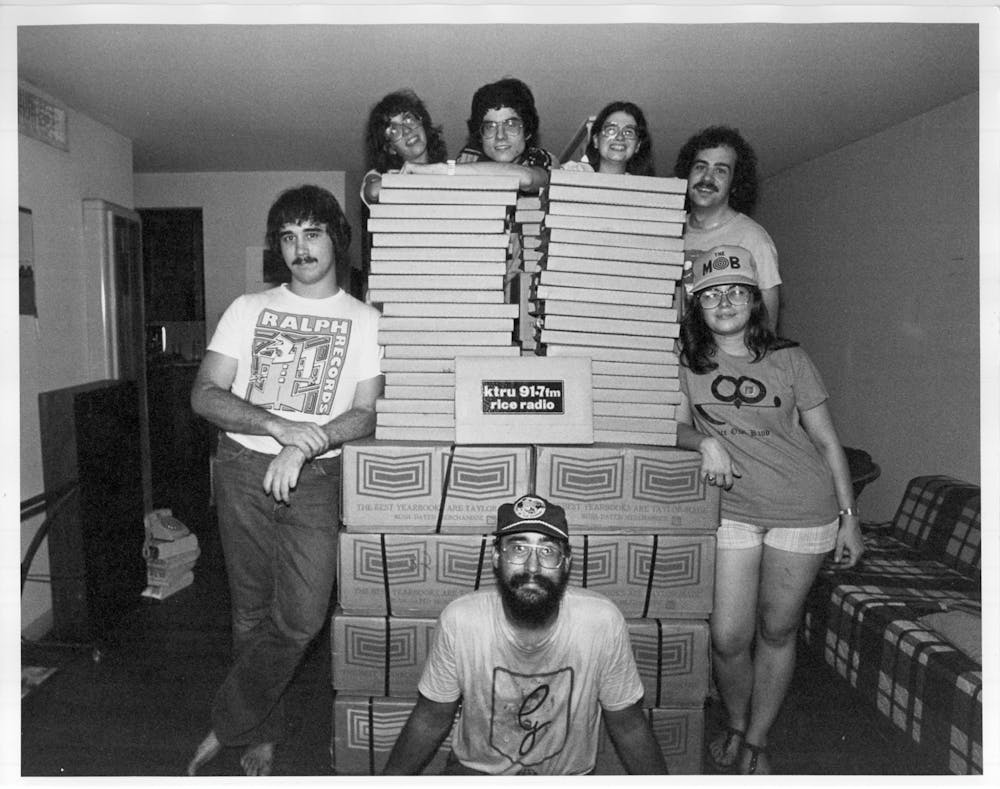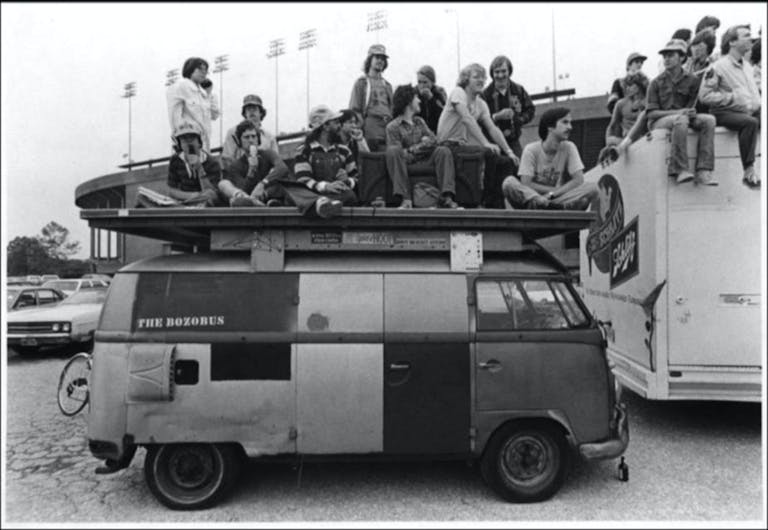Started in the basement, now we’re here: Explore ktru’s history

From the infamous yellow bumper stickers with rearranged letters to the often eclectic and unique range of music they share, the ktru radio station is an institution well known among the Rice community and even beyond the hedges. Despite this, few know the expansive history behind the iconic radio station and how it came to be the ktru we know and love.
In February 1967 from the Old Hanszen College basement, a group of students started a two-watt AM radio broadcast, and ktru was born — except it wasn’t quite ktru yet. KHCR, standing for “Hanszen College Radio,” served the students of Hanszen with news and music through low-tech equipment and the college’s buzzer system.
Shortly after its inception, ktru became KOWL in 1968 and was broadcast on 580 AM through wires that ran across the campus’ steam tunnels. Just three years later, the station was granted its FM license by the Federal Communications Commission and finally became ktru — standing for “The Rice University.” Broadcast with a 10-watt signal to an 8-mile radius of campus, ktru began broadcasting May 1971, and its broadcast tower sat atop the original Sid Richardson College.
A measure of a station’s signal strength, wattage determines a radio’s power output and how far the broadcast can be heard. Commercial stations typically broadcast at 50,000 or 100,000 watts, but ktru was not there quite yet. The station started to broadcast to stereo in October 1973 and was given permission by the FCC to expand to 250 watts shortly after in April 1974. This was further expanded to 650 watts in 1980, and they grew their broadcast to 24 hours a day in 1981.
When the Ley Student Center in the Rice Memorial Center was expanded to a second floor in 1987, ktru found its home there. In 1991, ktru expanded to a full 50,000 watts. A past Thresher article on the evolution of ktru explained that student DJs were wary of this decision, worried they would have to relinquish student control of the station, but were promised that this would not happen.
Despite its rapid expansion and estimated 23,000 listeners in Houston at the time, ktru has not been without its share of controversies. On Nov. 30, 2000, a Thresher article said that ktru was off the air indefinitely after two ktru DJs broadcast the last hour of a Rice women’s basketball game simultaneously with music. Then-Vice President for Student Affairs Zenaido Camacho pulled the plug on the station and called for a reorganization of their internal structure and management. The station was locked, iconic ktru bumper stickers were removed from the door and a sign posted read, “No Admittance. Violations Subject to Code of Student Conduct.”

While student programming returned to ktru Dec. 8, 2000, the structure of ktru changed significantly and Camacho decided that three to four Rice sports events per week, in addition to most tournament games, had to be broadcast on ktru for the next two years. This decision also called for the ktru station manager to now be elected by the student body and a constitution to be created that dictated internal structure along with the DJs.
In a Letter to the Editor for the Thresher, Rosa Maria Guerrero, a former Admissions Office staff assistant, even cited this ktru incident as a reason for her resignation after four and a half years in the role.
“I refuse to profit from an administration that chooses unilateral action when confronted with the natural struggles that arise from sitting at the helm of the unwieldy and wonderful ship that is Rice University,” Guerrero wrote at the time.
Back on the air, the first song ktru played was the jazz song by Miles Davis that was interrupted by static during the initial shutdown.
In 2010, disaster struck ktru again when news broke of a secret deal signed between Rice and University of Houston to sell ktru to KUHF by former Rice president David Leebron. ktru’s license, frequency and tower were handed over for $9.5 million after the deal was closed in May 2011.
“The issue [of selling ktru] has come up over the years, in part with the recognition that this is an asset that might decline in value and that ktru was not making use of 50,000 watts,” Leebron said at the time. “We have a responsibility to the university for making the best use of our resources.”
After this sale, ktru was an internet-only station until it returned to FM radio under the call sign KBLT-LP in October 2015, essentially resulting in the loss of legal use of the ktru call sign on air. In 2019, though, former ktru operations director Harrison Lorezen led the charge to buy back the radio station’s iconic call sign. After a Kansas Christian radio station using the ktru letters sold them to another entity in 2018, Lorenzen was able to negotiate the sale and reobtain the call sign with $10,000 from an anonymous donor.
Despite a few bumps in the road since its inception, Keegan Pierce, a current station manager and Lovett College senior, said that ktru has only continued to grow, especially in a post-COVID era. Boasting over 200 DJ applications in recent rounds and a variety of local Houston community DJs and musicians, Pierce said the station has become a way to connect Rice to the local music scene and allow a space for people to be themselves. The station streams on the low-power 96.1 FM and online.
More from The Rice Thresher

Letter from the editors’ desk: Journalism is a community practice
First of all, we want to thank y’all for picking up the paper, reading our stories and answering our questions all the time. We want to inform students, staff and the community about what is happening at Rice, and the only way to do that is by hearing from you. Talk to us, email us, submit tips on our website, write an opinion piece; however you want to communicate, we always want to know what matters to you.

12 things to know about Rice Athletics
The Owls are members of the American Conference, previously called the American Athletic Conference. The football program competes within the NCAA Division I Football Bowl Subdivision. Across campus, over 500 student-athletes currently compete in 14 varsity sports, with the 15th sport—women’s golf—to play its inaugural season in Fall 2026.


Please note All comments are eligible for publication by The Rice Thresher.